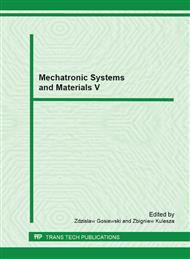p.338
p.344
p.350
p.356
p.365
p.371
p.379
p.384
p.390
Laboratory Tests of Shape Memory Alloy Wires
Abstract:
In this paper, tests on Shape Memory Alloy (SMA) wires for use in controlled actuators have been discussed. Selected static and dynamic characteristic curves being the result of experiments were presented in the article. Experiments were conducted at the Dynamics and Control of Structures Laboratory of the AGH University of Science and Technology. Laboratory tests of SMA wires used as actuators have been presented in the paper. Actuators made from the wires contract by about 4-5% of their length when heated, like small muscles, and loosen when cooled. SMA wires used as drives are significantly smaller than traditional solutions using motors or electromagnet to execute work. However, these actuators have flaws, such as strongly non-linear hysteresis. These are main problems in designing actuators, which is why SMA wires are often used in the construction of two-state actuators working as on-off actuators. The problems with SMA wires in their applications as drives are their static and dynamic properties, sensitivity to the environment, poor repeatability of production, non-linearity and hysteresis loop. The tested wires were made from a nickel and titanium alloy; this is an alloy which is often used in drive systems.
Info:
Periodical:
Pages:
365-370
Citation:
Online since:
March 2013
Authors:
Keywords:
Price:
Сopyright:
© 2013 Trans Tech Publications Ltd. All Rights Reserved
Share:
Citation:


